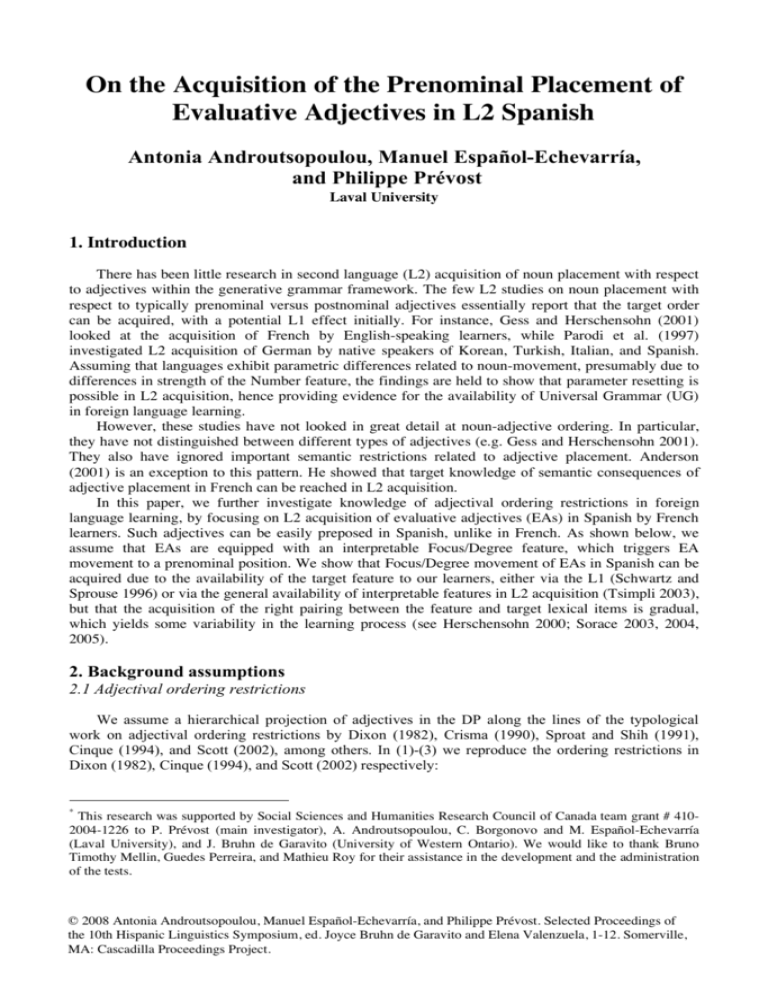
On the Acquisition of the Prenominal Placement of
Evaluative Adjectives in L2 Spanish
Antonia Androutsopoulou, Manuel Español-Echevarría,
and Philippe Prévost
Laval University
1. Introduction
There has been little research in second language (L2) acquisition of noun placement with respect
to adjectives within the generative grammar framework. The few L2 studies on noun placement with
respect to typically prenominal versus postnominal adjectives essentially report that the target order
can be acquired, with a potential L1 effect initially. For instance, Gess and Herschensohn (2001)
looked at the acquisition of French by English-speaking learners, while Parodi et al. (1997)
investigated L2 acquisition of German by native speakers of Korean, Turkish, Italian, and Spanish.
Assuming that languages exhibit parametric differences related to noun-movement, presumably due to
differences in strength of the Number feature, the findings are held to show that parameter resetting is
possible in L2 acquisition, hence providing evidence for the availability of Universal Grammar (UG)
in foreign language learning.
However, these studies have not looked in great detail at noun-adjective ordering. In particular,
they have not distinguished between different types of adjectives (e.g. Gess and Herschensohn 2001).
They also have ignored important semantic restrictions related to adjective placement. Anderson
(2001) is an exception to this pattern. He showed that target knowledge of semantic consequences of
adjective placement in French can be reached in L2 acquisition.
In this paper, we further investigate knowledge of adjectival ordering restrictions in foreign
language learning, by focusing on L2 acquisition of evaluative adjectives (EAs) in Spanish by French
learners. Such adjectives can be easily preposed in Spanish, unlike in French. As shown below, we
assume that EAs are equipped with an interpretable Focus/Degree feature, which triggers EA
movement to a prenominal position. We show that Focus/Degree movement of EAs in Spanish can be
acquired due to the availability of the target feature to our learners, either via the L1 (Schwartz and
Sprouse 1996) or via the general availability of interpretable features in L2 acquisition (Tsimpli 2003),
but that the acquisition of the right pairing between the feature and target lexical items is gradual,
which yields some variability in the learning process (see Herschensohn 2000; Sorace 2003, 2004,
2005).
2. Background assumptions
2.1 Adjectival ordering restrictions
We assume a hierarchical projection of adjectives in the DP along the lines of the typological
work on adjectival ordering restrictions by Dixon (1982), Crisma (1990), Sproat and Shih (1991),
Cinque (1994), and Scott (2002), among others. In (1)-(3) we reproduce the ordering restrictions in
Dixon (1982), Cinque (1994), and Scott (2002) respectively:
*
This research was supported by Social Sciences and Humanities Research Council of Canada team grant # 4102004-1226 to P. Prévost (main investigator), A. Androutsopoulou, C. Borgonovo and M. Español-Echevarría
(Laval University), and J. Bruhn de Garavito (University of Western Ontario). We would like to thank Bruno
Timothy Mellin, Guedes Perreira, and Mathieu Roy for their assistance in the development and the administration
of the tests.
© 2008 Antonia Androutsopoulou, Manuel Español-Echevarría, and Philippe Prévost. Selected Proceedings of
the 10th Hispanic Linguistics Symposium, ed. Joyce Bruhn de Garavito and Elena Valenzuela, 1-12. Somerville,
MA: Cascadilla Proceedings Project.
2
(1)
VALUE > DIMENSION > PHYSICAL PROPERTY > SPEED > HUMAN PROPENSITY > AGE
> COLOUR
Dixon (1982)
(2)
POSSESSIVE > CARDINAL > ORDINAL > QUALITY > SIZE > SHAPE > COLOR > NATION
Cinque (1994)
(3)
[QUANTIF Ordinal > Cardinal] > [SPEAK-ORIENT Subjective Comment > Evidential] >
[SCALAR PHYSICAL PROPERTY Size > Length > Height > Speed > Depth > Width] >
[MEASURE Weight > Temperature > ?Wetness > Age] > [NON-SCALAR PHYSICAL PROPERTY Shape > Color >
Nationality/Origin > Material]
Scott (2002)
In this paper, we focus on the category of evaluative adjectives, which corresponds to Dixon’s
value category in (1), Cinque’s quality category in (2), and Scott’s speaker oriented category in (3).
EAs are typically higher than size, shape, color, nationality, and relational adjectives. From a semantic
point of view, EAs contrast with most of the lower adjectives in the hierarchy (i.e. shape, color or
nationality adjectives, but not size adjectives) with respect to intersectivity. The denotation of an
intersective adjective plus the noun it modifies corresponds to the intersection of the individuals
denoted by the noun and those denoted by the adjective. Intersectivity can be captured by means of the
following meaning postulate, cf. Kamp and Partee (1995).
(4)
P D<e,t> . Q D<e,t> . x De . [ [[A]] (Q) (x) P(x) Q(x)].
The meaning postulate in (4) ensures that a red balloon is a red thing. Size and evaluative adjectives,
on the other hand, are not intersective (that is, they are subsective adjectives), and consequently, the
entailments in (5)-(6) do not hold1:
(5)
Dumbo is a small elephant.
-/-> Dumbo is a small animal.
(6)
Ralph is a good chess player.
-/-> Ralph is a good person.
These two types of adjectives involve scales in their interpretation. However, size adjectives, as well as
other scalar property adjectives, cf. (3), involve more or less objective scales, whereas EAs like good
or nice typically involve subjective scales.
2.2 Evaluative adjectives in French and Spanish
EAs show a different behavior in Spanish and French with respect to whether they can appear in
prenominal position. Many EAs may appear in both prenominal and postnominal positions in the two
languages, as shown in the examples in (7) and (8).
(7)
a.
b.
un agradable paseo / un paseo agradable.
une agréable promenade / une promenade agréable.
‘a pleasant walk.’
(8)
a.
b.
una dolorosa experiencia / una experiencia dolorosa.
une douloureuse expérience / une expérience douloureuse.
‘a painful experience.’
However, other EAs sound odd in a prenominal position in French, while being fully acceptable
postnominally, as shown in (9).
In contrast with the validity of (i) and (ii), without adjectives:
i. Dumbo is an elephant Dumbo is an animal.
ii. Ralph is a chess player Ralph is a person.
1
3
(9)
a.
b.
c.
d.
*une néfaste conséquence / une conséquence néfaste.
‘a fateful consequence.’
*un colossal monument / un monument colossal.
‘a colossal monument.’
*un fantastique film / un film fantastique.
‘a wonderful film.’
*une considérable somme / une somme considérable
‘a considerable sum.’
The Spanish counterparts of the adjectives in (9) can appear in both prenominal and postnominal
positions without any problem, cf. (10).
(10)
a.
b.
c.
d.
una nefasta consecuencia / una consecuencia nefasta.
‘a fateful consequence.’
un colosal monumento / un monumento colosal.
‘a colossal monument.’
una fantástica película / una película fantástica.
‘a wonderful film.’
una considerable suma / una suma considerable.
‘a considerable sum.’
The contrast between the examples in (9) and (10) indicates that the prenominal position is more
restricted in French than in Spanish with respect to evaluative adjectives. Such a difference is not
observed with other adjectival categories, such as shape, origin, color or relational adjectives, which
behave consistently in the two languages.
2.3 Adjective preposing
Several authors have proposed that prenominal adjectives attain their position via movement from
a postnominal position, cf. Abeillé & Godard (1999), Demonte (1999), Androutsopoulou (2000),
Laenzlinger (2004), Larson and Marusic (2004), Larson and Yamakido (2005, 2006)2, among others.
Demonte (1999) claims that a Degree feature is responsible for the movement of the adjective to a
prenominal position in Spanish, whereas Laezlinger (2004) proposes that a Strong subjectivity
(emphasis) feature triggers the same sort of movement in French DPs. In the present paper, we label
the interpretable feature triggering the movement of a postnominal adjective into a prenominal position
Focus/Degree and the movement that is triggered by it Focus/Degree movement. There are a number
of phenomena in the two languages which indicate that a derivational analysis of the relationship
between the two positions in terms of AP movement is on the right track.
First, EAs modifying two coordinated NPs in Spanish trigger different agreement patterns in
prenominal and postnominal positions, as shown in (11), cf. Bello (1847), RAE (1973), Demonte
(1999).
(11)
a.
b.
excelente(*s)
comida y servicio.
excellent-(*PL) food
and service
‘excellent food and service.’
comida y servicio excellente*(s).
food
and service excellent*(-PL)
‘excellent food and service.’
In (11a), the EA excelente ‘excellent’ precedes the modified coordinated nouns, and it appears in the
singular, whereas in (11b) the adjective follows the coordinated nouns it modifies and must appear in
the plural. This behavior can be accounted for if we take the prenominal adjective in (11a) to be
2
For Larson and Marusic (2004) and Larson and Yamakido (2005, 2006), the movement of the adjectival nominal
to a prenominal position is associated to Case assignment.
4
extracted from both conjuncts in some sort of Across-the-Board (ATB) extraction, cf. Ross (1967). On
the other hand, such an extraction does not take place in (11b) where the adjective shows plural
agreement with the coordinated NPs under a Spec-Head configuration, cf. Androutsopoulou &
Español-Echevarría (2006) for details.
Second, as observed by Leonetti (1999) and Demonte (1999), elative adjectives, i.e. adjectives
denoting a property in ‘high degree’, such as precioso ‘very beautiful’, horrible ‘horrible’ or
repugnante ‘repulsive’, as well as adjectives marked with the superlative affix -ísimo, are disallowed
as postnominal adjectives in DPs introduced by a definite determiner, as illustrated in (12a). On the
other hand, (12b) shows that all these adjectives are perfect in a prenominal position. The contrast in
(12) indicates a correlation between a property possessed in a high degree and the prenominal position
of the adjective. This correlation can be captured by claiming that elative adjectives are lexically
marked with a Focus/Degree feature triggering the movement of the adjective to a prenominal
position.3,4
(12)
a. ??/* El roedor precioso/horrible/repugnante/feísimo comía un pedazo de queso.
the rodent very beautiful/horrible/repulsive/ugly ate a piece of cheese
b.
El precioso/horrible/repugnante/feísimo roedor comía un pedazo de queso.
the very beautiful/horrible/repulsive/ugly rodent ate a piece of cheese
Third, certain adjectives can receive an additional evaluative interpretation in a prenominal
position, which is not available when the adjective is found postnominally, as shown by the contrast in
(13).
(13)
a.
b.
Penitas es un torero grande.
(* under an evaluative interpretation)
‘Penitas is a big bullfighter.’
Penitas es un gran torero.
(ok under an evaluative interpretation)
‘Penitas is a great bullfighter.’
In (13a), the adjective grande ‘great/big’ is interpreted as a size adjective, i.e. ‘big’, in a postnominal
position, whereas in a prenominal position, cf. (13b), grande receives an evaluative interpretation, i.e.
‘great’. Nonetheless, this evaluative interpretation can also obtain in postnominal position if the
adjective is focused or receives a high degree modification, as illustrated in (14):
(14)
a.
b.
Penitas es un torero GRANDE.
(ok under an evaluative interpretation)
‘Penitas is a GREAT/BIG bullfighter.’
Penitas es un torero muy grande. (ok under an evaluative interpretation)
‘Penitas is a very great/big bullfighter.’
The facts in (13)-(14) might be taken prima facie as evidence against the link between the prenominal
position of EAs and a Focus/Degree interpretation. However, the particular evaluative interpretation
that adjectives like grande ‘great/big’ may have in a prenominal position is available in a postnominal
position only under special conditions: when the adjectives receive focus stress, cf. (14a), or it is
modified by muy ‘very’. Although a detailed analysis of the derivations involved in (14) falls outside
3
Indefinite determiners contrast with definite ones in this respect, as shown by the acceptability of examples such
as the ones in (i):
(i)
Un roedor precioso/horrible/repugnante/feísimo comía un pedazo de queso.
a rodent very beautiful/horrible/repulsive/ugly ate a piece of cheese
This contrast could be related to the fact that indefinite determiners are plausibly licensed in a position lower that
D0, where definite determiners are licensed, as has been claimed by Kayne (1994) among others. The postnominal
position of the adjective in (i) obtains via remnant movement of the phrase containing the indefinite determiner
and the NP past the target position of Focus/Degree movement.
4
One anonymous reviewer finds the subject DPs in (12a) acceptable under a contrastive interpretation for the
adjective. One of the authors, as well as other native speakers consulted by the authors, find these DPs just very
marginal under any interpretation, see also Leonetti (1999) and Demonte (1999). We will not deal in this paper
with this difference on grammaticality judgements.
5
the scope of this paper, we may assume that the postnominal APs in (14) undergo covert movement to
the prenominal position normally hosting prenominal adjectives.5
Fourth, as observed in Demonte (1999), EAs in a prenominal position block generic readings on
subjects. These generic readings are nonetheless available when the evaluative adjective appears in a
postnominal position, as shown in the contrast in (15).
(15)
a.
b.
Los muchachos alegres siempre cantan. (ok under a generic interpretation)
‘Joyful boys always sing.’
Los alegres muchachos siempre cantan. (* under a generic interpretation)
‘The joyful boys always sing.’
The contrast in (15) can be accounted for as a result of an intervention effect induced by the displaced
prenominal adjective in (15b). The NP headed by muchachos contains a variable bound by a generic
operator at the sentential level. The displaced prenominal adjective “intervenes” on the binding
relation between the generic operator and the NP variable.
From the analysis of the facts presented in this section, we conclude that prenominal EAs are
displaced constituents which are lexically endowed with a Focus/Degree feature triggering movement
to a prenominal position. Certain lexical categories of adjectives are incompatible with this
Focus/Degree feature due to semantic reasons. For instance, non-gradable adjectives, such as shape,
nationality or relational adjectives do not bear a Focus/Degree feature and this is why they are
disallowed as prenominal adjectives in the general case. In addition, different tokens of adjectives
belonging to the same lexical category may or may not be able to bear a Focus/Degree feature. This
would account for the situation in French, where many EAs can prepose, cf. (7)-(8), whereas others
cannot. The former may contain a Focus/Degree feature, which is absent in the latter. On the other
hand, more evaluative adjectives in Spanish may include a Focus/Degree feature in their feature
specification; consequently more EAs may appear prenominally in Spanish than in French.6
3. Hypotheses and predictions
Current research in L2 acquisition suggests that phenomena at the interface between syntax and
other modules, such as semantics and pragmatics, are inherently more difficult to acquire than
phenomena that are purely syntactic in nature, which may result in optionality or variability, even in
highly proficient learners (Sorace 2003, 2004, 2005). One potential factor responsible for variability
includes L1 influence, even when the two languages involved share similar properties. For example,
Bini (1993) showed that Spanish learners of Italian at the intermediate level tend to overuse overt
subjects in contexts where null subjects are strongly preferred in Italian despite the fact that the
distribution of null and overt subjects follow similar constraints in both languages. The present study
sets up a different situation whereby the L2 is more systematic than the L1 with respect to the property
under investigation. As we have seen, the Focus/Degree feature may be included in the feature
specification of all EAs in Spanish, but of only some EAs in French (although some categories of
adjectives may have it as a whole in both languages, such as superlatives). The learners’ task is
therefore to extend the appearance of the target feature to the feature specification of more adjectives
than what is allowed in their L1. The input may not facilitate the acquisition process since prenominal
EAs can also occur postnominally in Spanish. This would make it difficult for the learners to establish
the presence of the Degree/focus feature on the relevant items. We thus expect a “gradual” acquisition
of the right pairing – feature-lexical item – and some variability in the acquisition process in the sense
that prenominalization will be allowed for some EAs but not for others. This prediction is also
compatible with Herschensohn’s (2000) Constructivist approach whereby the association of
interpretable features to lexical entries is done item by item in interlanguage (IL) grammars.
5
Alternatively, it can be claimed that the focused and degree modified adjectives in (14) have undergone
Focus/Degree movement and that the QP un torero ‘a bullfighter’ moves for PF reasons to the left of the displaced
adjective.
6
The facts in (11)-(15), supporting a movement analysis for prenominal EAs, hold also in French. For space
reasons, we do not discuss the relevant French data in this paper.
6
Nevertheless, we also hypothesize that Focus/Degree movement of EAs in Spanish can be
acquired due to the availability of the interpretable Focus/Degree features to our learners. Availability
of the target feature can obtain either via transfer of the L1 grammar (see Schwartz and Sprouse 1996)
or via access to interpretable features in general. Although researchers disagree as to the availability of
uninterpretable features in L2 acquisition (especially when these features have not been activated in
the L1, see Hawkins and Liszka 2003), there is general agreement, at least among those researchers
believing in UG-compatible IL grammars, that interpretable features can be part of such developing
systems (Hawkins 2005; Tsimpli 2003).
4. The study
4.1 Participants
As shown in Table 1, our study involved 11 NSs of Spanish (5 from Spain and 6 from Central and
South America) and 8 NSs of French (6 from Quebec and 2 from France) who acted as controls for
Spanish and French respectively, and 20 French-speaking learners of Spanish.7 Of these 20 learners, 10
were at the intermediate level and 10 at the advanced level, based on results from a multiple choice
task (the reading/vocabulary section of the MLA Cooperative Foreign Language Test (Educational
Testing Service, Princeton, NJ)) and a cloze test (from the Diploma de Español como Lengua
Extranjera (Spanish Embassy, Washington, DC)). All learners but two had started the acquisition of
Spanish at the age of 16 or above (the two others had started at the age of 12).
Table 1: Participants’ information
# of subjects
L1
Age
Spanish controls
French controls
11
Spanish
32.4 (21-38)
8
French
43.4 (30-74)
Intermediate
learners
10
French
28.1 (22-58)
Advanced
learners
10
French
32.2 (20-47)
4.2 Methodology
The participants were administered a grammaticality judgment task (GJT) comprising 61
sentences, 49 of which included prenominal adjectives. Different types of adjectives were used. First,
there were 13 prenominal EAs which are grammatical in Spanish. Their French equivalents were either
grammatical in a prenominal position (n=6) , as in (16a), or not (n=7), as in (16b).
(16)
a.
b.
Hay
una ligera diferencia entre
estas dos mesas.
there is a slight difference between these two tables
‘There’s a slight diffference between these two tables.’
Estamos ante
una preocupante situación en Irak.
(we) are in front of a preoccupying situation in Irak
‘We’re facing a preoccupying situation in Irak.’
Second, there were 12 non-evaluative high adjectives (NEHAs) in a prenominal position. These
are again grammatical in Spanish and their French equivalents may also be either grammatical in a
prenominal position (n=6), as in (17a), or not (n=6), as in (17b).
(17)
a.
b.
7
Sólo te quiero hacer una simple pregunta.
only you (I) want make a simple question
‘I only want to ask you a simple question.’
El siguiente paso en mi carrera será llegar a director de mi empresa.
the next
step in my career will be reach to director of my company
‘The next step in my career will be to become director of my company.’
Note that the 8 French controls were not part of the group of learners.
7
Finally, there were 24 adjectives whose occurrence in a prenominal position is ungrammatical in
both Spanish and French. These are non-evaluative low adjectives. Four kinds of adjectives located in
different positions along the hierarchy of adjectival projections were used, namely adjectives of shape
(18a), nationality or relation (18b), color (18c), and size (18d) (see Scott 2002). Six tokens of each
kind were used. We assume that such adjectives are not endowed with a Degree/focus feature.
(18)
a.
b.
c.
d.
* Encontramos una redonda mesa muy antigua en el sótano.
(we) found a round table very old
in the basement
* La española invasión de Portugal fue una catástrofe.
the Spanish invasion of Portugal was a catastrophy
* Me
compré un verde cepillo para limpiar las sillas.
to+me (I) bought a green brush to clean the chairs
* María tenía una alta planta en su dormitorio.
María had a high plant in her bedroom
An additional 12 distractor sentences were inserted, half of them grammatical. The participants
were asked to judge the sentences on a 4-point-scale, from 1 to 4, where 1 meant “totally
unacceptable” and 4 “totally acceptable”. A French version of the test was administered to the French
controls.
It is important to point out that the learners were handed a vocabulary sheet listing all the
words, including the adjectives, used in the tests. The learners were also invited to ask any vocabulary
questions to the test administrator during the test.
5. Results
5.1 General and group results
5.1.1 Prenominal high adjectives (evaluative and non-evaluative)
Table 2 reports the results on EAs and NEHAs in a prenominal position. All sentences are
grammatical in Spanish, whereas some of the corresponding sentences are ungrammatical in French.
Note that the results on the French controls reflect their performance on the French version of the test.
Table 2: Mean answers on prenominal EAs and NEHAs (grammatical sentences in Spanish)
Adjective type
EAs (G in French)
EAs (U in French)
Spanish controls
(n=11)
3.712
3.792
French controls
(n=8)
3.708***
3.018
Advanced
(n=10)
3.317**
2.729
Intermed
(n=10)
3.22*
2.771
NEHAs (G in French)
NEHAs (U in French)
3.864**
3.515
3.833****
1.833
3.683***
2.667
3.17
2.85
Significant difference between the corresponding grammatical and ungrammatical sentences in French:
* p<.05; ** p<.01; *** p<.001; **** p<.0001 (ANOVA)
As can be seen, the Spanish controls performed as expected, accepting all sentences. The mean
answers are at least 3.5 out of 4.8 The French controls also performed as expected, distinguishing
between the different types of adjectives. Significant differences were found between the grammatical
sentences and the ungrammatical ones, both with EAs and NEHAs, although the results on EAs
deemed to be ungrammatical in a prenominal position look relatively high (3.018). In fact, the
performance of the French controls on these EAs is significantly higher than on the NEHAs whose
occurrence in a prenominal position is also ungrammatical in French (1.833) (p<.0001). This
8
It is not clear why a significant difference was found between the different types of NEHAs (depending on the
grammatical status of their prenominalization in French), but note that the scores were above 3.5, which suggests
acceptability.
8
notwithstanding, the French controls performed significantly worse than the Spanish controls on
ungrammatical EA prenominalization in French (3.018 vs. 3.792; p<.001), as well as on
ungrammatical NEHA prenominalization in French (1.833 vs. 3.515; p<.0001).
We now turn to the learners, starting with their performance on evaluative adjectives. There, the
intermediate and advanced learners performed similarly in the sense that there is a significant
difference between EAs, depending on whether their prenominal positioning is acceptable in the L1 or
not. Such an L1 effect is confirmed by the fact that the learners’ performance is not significantly
different from the French controls’ on prenominal EAs that are ungrammatical in French. With respect
to non-evaluative high adjectives, the advanced learners and the intermediates performed differently.
While the latter group showed no significant difference between the adjectives that are grammatical
and ungrammatical in French in a prenominal position, the advanced learners did. However, both
groups performed similarly in the sense that their scores on ungrammatical NEHA prenominalization
in French (2.667 for the advanced and 2.85 for the intermediates) are significantly higher than the
French controls’ (1.833) (p<.0001). Moreover, there is no significant difference between the learners’
performance on ungrammatical EA prenominalization in French and ungrammatical NEHA preposing
(2. 729 vs. 2.667 for the advanced and 2.771 vs. 2.85 for the intermediates), in contrast to what we saw
with the French controls. In other words, the learners have managed to go beyond what is allowed by
their L1.
5.1.2 Prenominal (non-evaluative) low adjectives
The mean results on prenominal low adjectives, namely adjectives of shape, nationality, relation,
color, and size, are given in Table 3. The corresponding sentences are ungrammatical in Spanish (and
in French), so target-like answers should be below 2.
Table 3: Mean answers on prenominal low adjectives (ungrammatical sentences)
Adjective type
Shape
Nationality and relation
Color
Size
Spanish controls
(n=11)
1.542
1.409
1.621
2.788
French controls
(n=8)
1.292
1.312
1.438
2.896
Intermediate
(n=10)
2.55
2.117
2.163
2.95
Advanced
(n=10)
1.45
1.417
1.4
2.267
As can be seen, the Spanish and French controls performed as expected, except on size adjectives,
where mean answers are close to 3. There is no significant difference between the two groups on any
type.
The advanced learners performed much like the controls, with a low score on prenominal
adjectives of shape, nationality, relation, and color, and a higher score on size adjectives. No
significant differences were found between these learners and either the French controls or the Spanish
controls on any type. Finally, the intermediate learners performed differently from any other group. In
particular, their acceptance scores were significantly higher than any other groups on each adjective
type, except size adjectives. Interestingly, the corresponding sentences are also ungrammatical is their
L1. Despite this poor performance, it is very important to stress that the scores of the intermediate
learners are significantly lower than their scores on EAs and NEHAs. This particularly applies to
nationality, relation, and color adjectives. This suggests that the learners have knowledge of the
adjectival hierarchy described in section 2.1.
5.2 Individual results
In order to compute individual results, we assumed that target-like positioning of an adjective was
acquired if a participant performed above 3 for grammatical placement and below 2 for ungrammatical
placement.
9
5.2.1 Evaluative and non-evaluative high adjectives
Following our calculation method, we found that the Spanish controls performed as expected on
EAs and NEHAs: almost all of them scored above 3 on the corresponding sentences. The French
controls displayed interesting individual behaviors. As can be seen in Table 4, two sub-groups of
French controls can be distinguished: those who accepted ungrammatically placed EAs and correctly
rejected ungrammatically placed NEHAs (these participants appear above the thick line in Table 4);
and those who accepted all ungrammatically prenominalized EAs and NEHAs (under the thick line in
Table 4). The other observation is that ungrammatically prenominalized EAs were systematically rated
above 2 by the French controls.
Table 4: French controls’ individual results on prenominal EAs and NEHAs
#
100
101
102
103
107
104
105
106
EAs (G)
EAs (U)
x
x
x
x
x
x
x
x
NEHAs (G)
NEHAs (U)
x
x
x
Table 5 displays the individual results of the learners on prenominalized EAs and NEHAs in
Spanish. Three kinds of behavior were identified: target-like (whereby all adjectives were accepted
prenominally), L1-like (whereby some prenominal EAs and NEHAs were rejected in Spanish based on
L1 properties), and other (whereby no particular trend could be identified). The latter behavior was
particularly typical of the intermediate learners who displayed different patterns of answers: some
learners rejected one type of adjective in a prenominal position, but not always the same one, while
others rejected three types of adjectives, included EAs that may appear in a prenominal position in
both Spanish and French. These behaviors show strong variability which cannot be fully explained by
the L1. As to the advanced learners, prenominal EAs that are ungrammatical in French were mostly
rejected in Spanish, while NEHAs that are also ungrammatical in a prenominal position in French were
not all rejected. There is also variability, but it is less wide than with the intermediates, and it is more
L1-consistent. Finally, three learners managed to make target-like judgments on EAs and NEHAs (one
intermediate and two advanced), which suggests that despite the difficulty of acquisition, native-like
grammars may be reached.
Table 5: Learners’ individual results on prenominal EAs and NEHAs
Participants
Intermediates (n=10)
Advanced (n=10)
Target-like
1
2
L1-like
3
6
Other
6
2
5.2.2 Low (non-evaluative) adjectives
The occurrence of low adjectives in a prenominal position was deemed ungrammatical in both
French and Spanish. The French and Spanish controls all rejected prenominal adjectives of shape,
nationality, relation, and color. However, they displayed scores above 2 on size adjectives. Turning to
the learners (Table 6), we can see that the intermediates once again gave different patterns of answers.
In particular, some learners accepted all sentences, although they are ungrammatical in their L1.
Variability obtains again, and it is not always due to the L1. The advanced learners performed like the
French and Spanish controls, whereby size adjectives were not rejected in a prenominal position, in
contrast to the other adjectives.
10
Table 6: Learners’ individual results on non-evaluative low adjectives
Participants
Intermediates (n=10)
Advanced (n=10)
Target/L1-like
3
9
Other
7
1
6. Discussion
6.1 On French and Spanish
As expected, French ‘preposes’ with more difficulty than Spanish, as seen by the results of the
French controls on EAs and NEHAs. The French controls did not accept all adjectives in a prenominal
position to the same degree, including EAs. In contrast, all prenominal EAs and NEHAs were highly
accepted by the Spanish controls.
Both languages also respect a bottom-up hierarchical representation of adjectives, all the way
towards evaluative adjectives, since preposition of adjectives deemed to be lower on this hierarchy is
much less accepted. This tendency does not seem to apply to size adjectives whose occurrence in a
preposed position was accepted to greater extent than for any other non-evaluative low adjective, in all
control participants. This indicates that prenominalization is tied to intersectivity (see section 2.1
above). This semantic property distinguishes evaluative and size adjectives from the rest of low
adjectives. With respect to NEHAs, which are located above evaluative adjectives, the results on the
adjectives we have tested so far suggest that a different "hierarchy" starts all over again, though it is
not clear that it is just bottom-up. This also suggests that a different parameter/preposing mechanism is
at work.
6.2 On L2 acquisition of adjective placement
Our results show that prenominal adjectives are a source of confusion for L2 learners of Spanish.
This is mainly seen in the intermediate learners who displayed different types of behaviors, some of
them accepting adjectives in a position which is ungrammatical in both languages. There is variability,
in that some EAs are allowed pronominally but not others, but it is not always related to the L1 (see
also Sorace 2003, 2004, 2005). As such, the results mirror what is reported in Bini’s (1993) study of
Spanish-speaking learners of Italian, namely variability may be observed in IL grammars on properties
that are nonetheless present in the two languages. In fact, our results on preposed low adjectives are
unexpected on a Full transfer account (e.g. Schwartz and Sprouse 1996), given that these adjectives
can hardly be preposed in the L1. This notwithstanding, the intermediate learners obtained lower
scores on prenominal low adjectives than on prenominal EAs and NEHAs. This shows that they accept
prenominalization to a lower extent with low adjectives than with high ones, which in turn suggests
that there is knowledge of the adjectival hierarchy described in section 2.1. In other words, although
there is more variability than in the advanced learners, it is not the case that anything goes in
intermediate IL grammars: the possibility of prenominalization is still related to the position of the
adjective in the hierarchy.
Interestingly, we also observed an evolution of variability along the acquisition process, such that
variability at the advanced learners is much more L1-consistent than at the intermediate level. Very
simply put, it is as if after an initial period of confusion, learners fell back onto L1 patterns. L1induced variability in advanced learners has been found in other studies, such as the acquisition of
verb-placement in L2 German (Robertson and Sorace 1999), although it may be less wide than what
has been observed here.9 Note that there is also evidence of the presence of the hierarchy of adjectives
in our advanced learners’ IL grammars, given that low adjectives are strongly disallowed in a
prenominal position. One should also point out that variability may be overcome, as some of the
learners displayed native-like intuitions.
9
The learners investigated by Robertson and Sorace (1999) were deemed to have reached an endstate stage of
acquisition, which was not necessarily the case of our learners. It would be interesting to investigate the extent of
variability and L1 influence in EA placement in L2 Spanish by French-speaking learners at more advanced stages.
11
Following Herschensohn’s (2000) Constructivist approach, according to which [+interpretable]
features are underspecified in (intermediate) IL grammars and specification takes place in an item to
item fashion, we propose that the Degree/Focus feature is underspecified in the initial phases of
development and that it gradually becomes specified on EAs. Crucially, the gradual specification
process would first become L1-consistent before becoming native-like. Delayed L1 influence has been
reported elsewhere, e.g. Hawkins (2001) who proposes that L1 transfer of functional categories, such
as IP, does not occur initially but is triggered by the acquisition of specific lexical items, such as the
copula (see also Myles 2005). It would be interesting to see whether such delayed L1 influence also
obtains in the other learning direction, i.e. from Spanish to French. If it did, it would mean that after an
initial period of underspecification, the Degree/Focus feature would appear in the feature bundle of
more EAs than allowed in the target language, triggering overuse of EA preposing in L2 French.
References
Anderson, Bruce (2001). Adjective position and interpretation in L2 French. In Joaquim Camps and Caroline R.
Wiltshire (eds), Romance syntax, semantics and their L2 acquisition (pp. 27-46). Amsterdam: John
Benjamins.
Abeillé, Anne, and Danièle Godard (1999). La position de l’adjectif épithète en français: le poids des mots.
Recherches Linguistiques de Vincennes 28: 9-32.
Androutsopoulou, Antonia (1994). The distribution of the definite determiner and the syntax of Greek DPs. In
CLS 30: Papers from the 30th regional meeting of the Chicago Linguistic Society. Volume 1: The main
session (pp. 16-29). University of Chicago.
Androutsopoulou, Antonia (2000). On the (in)ability of prenominal attributive adjectives to take complements.
WCCFL 19: 29-42. Stanford: CSLI Publications.
Androutsopoulou, Antonia, and Manuel Español-Echevarría (2006). Degree modifiers and DP-internal agreement.
Ms. Université Laval.
Bello, Andrés (1847). Gramática de la lengua española destinada al uso de los americanos. Santiago de Chile:
Imprenta del Progreso.
Bini, Milena (1993). La adquisición del italiano: más allá de las propriedades sintácticas del parámetro pro-drop.
In Juana Liceras (ed), La linguistica y el analisis de los sistemas no nativos (pp. 126-139). Ottawa:
Doverhouse.
Cinque, Guglielmo (1994). On the evidence for partial N-movement in the Romance DP. In Guglielmo Cinque,
Jan Koster, Jean-Yves Pollock, Luigi Rizzi and Rafaella Zanuttini (eds), Paths toward Universal Grammar:
Studies in honor of Richard S. Kayne (pp. 85-110). Washington D.C.: Georgetown University Press.
Demonte, Violeta (1999). A minimal account of Spanish adjective position and interpretation. In Jon A. Franco,
Alazne Landa and Juan Martin (eds), Analyses in Basque and Romance linguistics. Papers in honor of Mario
Saltarelli (pp. 45-76). Amsterdam: John Benjamins.
Dixon, Robert M. W. (1982). Where have all adjectives gone? and other essays in semantics and syntax. The
Hague: Mouton.
Gess, Randall, and Julia Herschensohn (2001). Shifting the DP parameter: A study of anglophone French L2ers.
In Joaquim Camps and Caroline R. Wiltshire (eds), Romance syntax, semantics and their L2 acquisition (pp.
105-119). Amsterdam: John Benjamins.
Hawkins, Roger (2001). Second language syntax: A generative introduction. Oxford: Blackwell.
Hawkins, Roger (2005). Revisiting Wh-movement: The availability of an uninterpretable [wh] feature in
interlanguage grammars. In Laurent Dekydtspotter, Rex A. Sprouse and Audrey Liljestrand (eds),
Proceedings of the 7th Generative Approaches to Second Language Acquisition Conference (GASLA 2004)
(pp. 124-137). Somerville, MA.: Cascadilla Press.
Hawkins, Richard, and Sarah Liszka (2003). Locating the source of defective past tense marking in advanced L2
English speakers. In Roeland van Hout, Aafke Hulk, Folkert Kuiken and Richard Towell (eds), The lexiconsyntax interface in second language acquisition (pp. 21-44). Amsterdam: John Benjamins.
Herschensohn, Julia (2000). The second time around: Minimalism and L2 acquisition. Amsterdam: John
Benjamins.
Kamp Hans, and Barbara Partee (1995). Prototype theory and compositionality. Cognition 57: 129-191.
Kayne, Richard (1994). The antisymmetry of syntax.Cambridge, MA: MIT Press.
Laenzlinger, Christopher (2004). French adjective ordering: perspectives on DP-internal movement types. Lingua
115: 645-689.
Larson, Richard (1991). The Projection of DP (and DegP). Ms. SUNY-Stony Brook.
Larson, Richard, and Franc Marusic (2004). On Indefinite pronoun structures with APs: Reply to Kishimoto.
Linguistic Inquiry 35: 268-287.
12
Larson, Richard, and Hiroko Yamakido (2005). Ezafe and the deep position of nominal modifiers. Paper presented
at the Barcelona Workshop on Adjectives and Adverbs. Pompeu Fabra University, Barcelona, Spain.
Larson, Richard, and Hiroko Yamakido (2006). Zazaki double Ezafe as double Case-marking. Paper presented at
the Linguistic Society of America annual meeting. Albuquerque, NM.
Leonetti, Manuel (1999). El artículo. In Ignacio Bosque and Violeta Demonte (eds), Gramática descriptiva de la
lengua española (pp. 787-890). Madrid: Espasa-Calpe.
Myles, Florence (2005). The emergence of morpho-syntactic structure in French L2. In Jean-Marc Dewaele (ed),
Focus on French as a foreign language: Multidisciplinary approaches (pp. 88-113). Clevedon: Multilingual
Matters.
Parodi, Teresa, Bonnie D. Schwartz, and Harald Clahsen (1997). On the L2 acquisition of the morphosyntax of
German nominals. Essex Research Reports in Linguistics 15: 1-43.
Real Academia Española (RAE) (1973). Esbozo de una nueva gramática de la lengua española. Madrid: EspasaCalpe.
Robertson, Daniel, and Antonella Sorace (1999). Losing the V2 constraint. In Eleine Klein and Gita
Martohardjono (eds), The development of second language grammars: A generative approach (pp. 317-362).
Amsterdam: John Benjamins.
Ross, John Roberts (1967). Constraints on variables in Syntax. PhD dissertation. MIT.
Schwartz, Bonnie D., and Rex A. Sprouse (1996). L2 cognitive states and the Full Transfer/Full Access Model.
Second Language Research 12: 40-72.
Scott, Gary-John. (2002). Stacked adjectival modification and the structure of nominal phrases. In Guglielmo
Cinque (ed), Functional structure in DP and IP: The cartography of syntactic structures, vol. 1 (pp. 91-120).
Oxford: Oxford University Press.
Sorace, Antonella (2003). Near-nativeness. In Catherine Doughty and Michael Long. Oxford (eds), The handbook
of second language acquisition (pp. 130-151). Oxford: Blackwell.
Sorace, Antonella (2004). Native language attrition and developmental instability at the syntax-discourse
interface: Data, interpretations and methods. Bilingualism: Language and Cognition 7: 143-145.
Sorace, Antonella (2005). Syntactic optionality at interfaces. In Leonie Cornips and Karen Corrigan (eds), Syntax
and variation: Reconciling the biological and the social (pp. 46-111). Amsterdam: John Benjamins.
Sproat, Richard and Chilin Shih (1991). The cross-linguistic distribution of adjective ordering restrictions. In
Carol Georgopoulos and Roberta Ishihara (eds), Interdisciplinary approaches to language (pp. 565-593).
Dordrecht: Kluwer.
Tsimpli, Ianthi Maria (2003). Clitics and determiners in L2 Greek. In Juana Liceras, Helmut Zobl and Helen
Goodluck (eds), Proceedings of the 6th Generative Approaches to Second Language Acquisition Conference
(pp. 331-339). Somerville, MA.: Cascadilla Press.
Selected Proceedings of the
10th Hispanic Linguistics Symposium
edited by Joyce Bruhn de Garavito
and Elena Valenzuela
Cascadilla Proceedings Project
Somerville, MA
2008
Copyright information
Selected Proceedings of the 10th Hispanic Linguistics Symposium
© 2008 Cascadilla Proceedings Project, Somerville, MA. All rights reserved
ISBN 978-1-57473-427-0 library binding
A copyright notice for each paper is located at the bottom of the first page of the paper.
Reprints for course packs can be authorized by Cascadilla Proceedings Project.
Ordering information
Orders for the library binding edition are handled by Cascadilla Press.
To place an order, go to www.lingref.com or contact:
Cascadilla Press, P.O. Box 440355, Somerville, MA 02144, USA
phone: 1-617-776-2370, fax: 1-617-776-2271, e-mail: sales@cascadilla.com
Web access and citation information
This entire proceedings can also be viewed on the web at www.lingref.com. Each paper has a unique document #
which can be added to citations to facilitate access. The document # should not replace the full citation.
This paper can be cited as:
Androutsopoulou, Antonia, Manuel Español-Echevarría, and Philippe Prévost. 2008. On the Acquisition of the
Prenominal Placement of Evaluative Adjectives in L2 Spanish. In Selected Proceedings of the 10th Hispanic
Linguistics Symposium, ed. Joyce Bruhn de Garavito and Elena Valenzuela, 1-12. Somerville, MA: Cascadilla
Proceedings Project.
or:
Androutsopoulou, Antonia, Manuel Español-Echevarría, and Philippe Prévost. 2008. On the Acquisition of the
Prenominal Placement of Evaluative Adjectives in L2 Spanish. In Selected Proceedings of the 10th Hispanic
Linguistics Symposium, ed. Joyce Bruhn de Garavito and Elena Valenzuela, 1-12. Somerville, MA: Cascadilla
Proceedings Project. www.lingref.com, document #1781.









